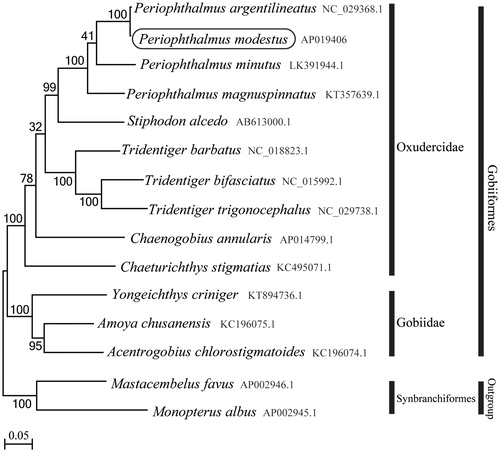Abstract
The complete mitochondrial genome was determined for the shuttles hoppfish Periophthalmus modestus belonging to the family Oxudercidae. The length of the complete mitochondrial genome is 16,510 bp and has the typical vertebrate mitochondrial gene arrangement, consisting of 13 protein-coding genes, 22 tRNA genes, two rRNA genes, and a control region. Phylogenetic analysis using mitochondrial genomes of 15 species showed that P. modestus formed a well-supported monophyletic group with genus Periophthalmus species and rooted with other Oxudercidae species.
The shuttles hoppfish Periophthalmus modestus (Gobiiformes, Oxudercidae) is distributed throughout the marginal seas of the northwestern Pacific, including China, Japan and Korea (Murdy Citation1989). Its belonging family Oxudercidae, mudskippers, are amphibious fish that inhabit mudflats, muddy creeks and lagoons and mangrove forests mostly in the tropics and subtropics (Baeck et al. Citation2008). Although previous molecular phylogenetic studies indicated the family Gobiidae is divided into two major clades, the families Oxudercidae and Gobiidae (Thacker and Roje Citation2011; Chakrabarty et al. Citation2012; Thacker Citation2013), the members of these two families remains controversial because both the Oxudercidae and Gobiidae are highly diverse, with many genera and potentially many subgroups. In the current study, we first determined the complete mitochondrial DNA sequence of P. modestus, and analyzed the phylogenetic relationship of this species with members of Oxudercidae and Gobiidae.
The P. modestus specimen used in this study was collected at Seocheon, Korea (36.01N, 126.39E) in June 2018. Total genomic DNA was extracted from tissue of the specimen, which has been deposited in the National Marine Biodiversity Institute of Korea (Voucher no. MABIK TI00002734). The mitogenome was sequenced and assembled using Illumina Hiseq 4000 sequencing platform (Illumina, San Diego, CA) and SOAP denovo assembler at Macrogen Inc. (Seoul, Korea), respectively. The complete mitochondrial genome was annotated using MacClade ver. 4.08 (Maddison and Maddison Citation2005) and DNASIS ver. 3.2 (Hitachi Software Engineering, Tokyo, Japan).
The complete mitochondrial genome of P. modestus (GenBank accession no. AP019406) is 16,510 bp long, and includes 13 protein-coding genes, 22 tRNA genes, two rRNA genes, and a control region. The ND6 gene and eight tRNA genes are encoded on the light strand. The overall base composition of the heavy strand is 28.29% A, 27.85% C, 16.02% G, and 27.84% T. Similar to the mitogenomes of other vertebrates, the AT content is higher than the GC content (Saccone et al. Citation1999). All tRNA genes can fold into a typical cloverleaf structure, with lengths ranging from 65 to 76 bp. The 12S rRNA (956 bp) and 16S rRNA genes (1691 bp) are located between tRNAPhe and tRNAVal and between tRNAVal and tRNALeu(UUR), respectively. Of the 13 protein-coding genes, 12 begin with an ATG start codon; the exception being the COI gene, which start with GTG. The stop codon of the protein-coding genes is TAA in ND1, ND2, COI, ND4L, ND5, and ND6; TAG in ATP8; and T in the remaining six genes. The control region (840 bp) is located between tRNAPro and tRNAPhe.
Phylogenetic trees were constructed by the maximum-likelihood method using MEGA 7.0 software (Kumar et al. Citation2016) for the newly sequenced genome and a further 14 complete mitochondrial genome sequences downloaded from the National Center for Biotechnology Information. We confirmed that P. modestus formed a monophyletic group with other Oxudercidae members with high statistical support ().
Acknowledgements
This work was supported by grant from the National Marine Biodiversity Institute Research Program [2019M00600] and the Marine Biotechnology Program [20170488] funded by the Ministry of Oceans and Fisheries, Korea.
Disclosure statement
The authors report no conflict of interests. The authors alone are responsible for the content and writing of the paper.
References
- Baeck GW, Takita T, Yoon YH. 2008. Lifestyle of Korean mudskipper Periophthalmus magnuspinnatus with reference to a congeneric species Periophthalmus modestus. Ichthyol Res. 55:43–52.
- Chakrabarty P, Davis MP, Sparks JS. 2012. The first record of a trans-oceanic sister-group relationship between obligate vertebrate troglobites. PLoS One. 7:e44083.
- Kumar S, Stecher G, Tamura K. 2016. MEGA7: molecular evolutionary genetics analysis version 7.0 for bigger datasets. Mol Biol Evol. 33:1870–1874.
- Maddison DR, Maddison WP. 2005. MacClade 4: analysis of phylogeny and character evolution. ver. 4.08. Sunderland (MA): Sinauer Associates.
- Murdy EO. 1989. A taxonomic revision and cladistic analysis of the oxudercine gobies (Gobiidae: Oxudercinae). Rec Aust Mus Suppl. 11:1–93.
- Saccone C, De Giorgi C, Gissi C, Pesole G, Reyes A. 1999. Evolutionary genomics in Metazoa: the mitochondrial DNA as a model system. Gene. 238:195–209.
- Thacker CE. 2013. Phylogenetic placement of the European sand gobies in Gobionellidae and characterization of gobionellid lineages (Gobiiformes: Gobioidei). Zootaxa. 3619:369–382.
- Thacker CE, Roje DM. 2011. Phylogeny and evolution of Indo-Pacific shrimp-associated gobies (Gobiiformes: Gobiidae). Mol Phylogenet E. 52:735–745.

